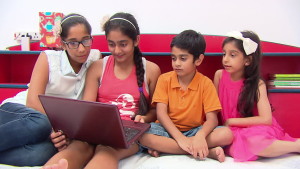For most students, January means a return to school after a winter vacation, it means kids need to be ready to get back into their routines and work harder than they did during the break. Winter break brings loosened reins on TV, computer and other media. It’s easy for kids to become night owls as they know they can sleep in the next morning. Both of these habits can make the first week back to school challenging, even for the most motivated student. Before sending him back to the grind, taper back on screen time and ease back to a reasonable bedtime.These tips will help you to manage screen time and help you get your kids into the back-to-school mode.
1. Create tech-free times at home. An easy way to ensure that a device is being used appropriately is to create times where the tech is banned: at the dinner table, during family time or before bed. And don’t be afraid to be tough. If you feel like your child is using the device too much, there’s a really simple solution — you take away the device.
2. Designate a charging area. To make sure that children aren’t using the device late at night, or to goof off after homework, have a rule that devices must charge in the parent’s bedroom, in the kitchen, or in another location away from children’s bedrooms.
3. Be a positive role model. If there’s a tech-free time, such as at dinner, be sure you’re also not on your phone or distracted by technology. That just reinforces the idea to the child that it’s OK to have this
4. Be active yourself. Encourage everyone in the family to be active. Go swimming, ride bikes, go walking as a family. Look for things to do together that don’t involve being huddled around a screen.
5. Talk about why too much time in front of a screen can be a bad thing. Talk how most things are OK but in moderation. Keep to your own rules! Two hours screen time for them – two hours screen time for you. Keep a family screen time diary for a week.“My son is 10 and is addicted to his Xbox. We’ve restricted use to two hours on a school night, and I insist he also reads for a minimum of 15 minutes per night. At weekends, he gets a bit more freedom, but if he gets too noisy or angry he has to come straight off” says Mr. Nikhil Gupta father of 2 sons.
6. Be very careful before you agree to a child having a screen in their bedroom. Many parents say they’d never allow it. “I make sure I keep the laptop and phones with me at night. Kids are not allowed to use any gadgets post dinner. If they have worked also, they know they have to finish it before dinner.” says Mrs. Agnihotri. Some who have allowed it, regret it later.
7. Turn off the TV during family meals. Have a rule about no mobiles at the table – for anyone, parents included. Also, don’t use ‘no TV’ or ‘no computer’ as a reward or as a punishment – that will make screen time even more important and precious.
8. Use parental control apps like Nischint to reduce and manage screen time. You can lock phone, block apps, schedule apps and much more.
While it’s good to put faith in your kids, it never hurts to check in on them from time to time. If no one’s ever checking that, the child may feel like they can get away with anything. Also if a child is always turning the screen away from a parent, or closing the lid, “there’s probably a reason for that.” It’s advisable for parents to always monitor their child’s internet and digital usage to know what they are doing online. Nischint helps you to manage, monitor and protect your kid’s digital activity remotely.
Nischint is a parental control solution whose prime focus is to create a safe digital environment for children today. We help children learn how to use their devices responsibly and also provide parents with the ability to monitor their child’s lives online. With Nischint parents can schedule app and device usage, so that children can focus while they are at school/studying/playing and they get to experience the best of both worlds.













